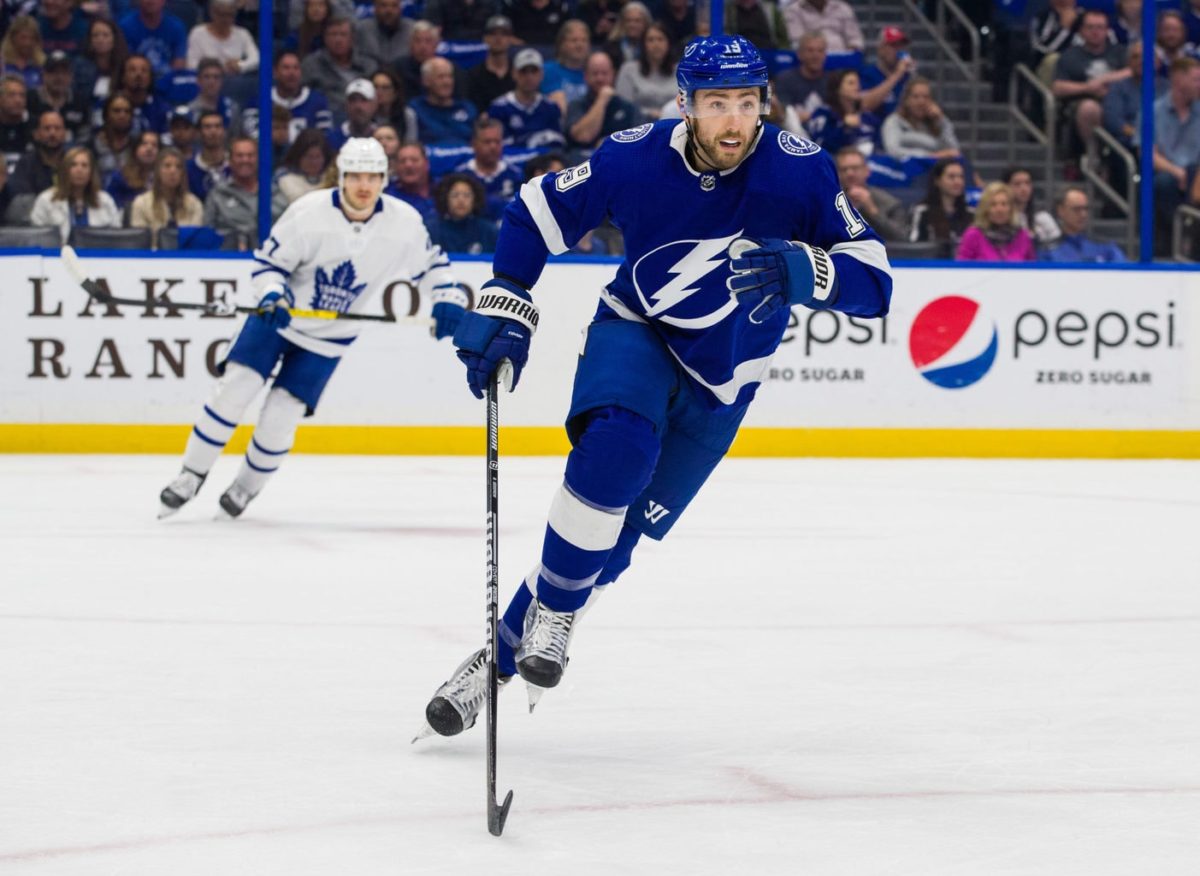Oftentimes, hockey fans debate the merits of building “heavy,” physical, hard-hitting teams. Many fans believe the grit that these teams possess tremendously helps them win championships. On the other hand, numerous fans believe in building a team that focuses more on a high-speed, high-scoring, offensive-oriented game. Although teams of the latter category thrive in the regular season (e.g. the Toronto Maple Leafs), teams in the former category have proven to be more successful in the playoffs.

The 2021 playoffs have highlighted that physicality is needed to win in the playoffs, but numerous other recent playoffs back up this fact.
2020 Playoffs
The 2020 Stanley Cup Playoffs are the best indicator that the philosophy of building heavy teams proves successful in the playoffs. The four teams that threw the most hits per game in the 2020 playoffs were:
Tampa Bay Lightning – 47.04 hits per game
Dallas Stars – 43.74 hits per game
New York Islanders – 43.55 hits per game
Vegas Golden Knights – 39.75 hits per game
Tellingly, these were the final four teams standing in the 2020 postseason. Tampa Bay, which threw the most hits per game, went on to win the Stanley Cup. Dallas, which was second in this regard, made it to the Stanley Cup Final. The Islanders, who were third, had a six-game Eastern Conference Final against the Lightning, while Vegas, who threw the fourth-most hits per game, had a shorter, five-game Western Conference Final versus Dallas. Combined, these teams had 10 out of the 50 players who threw the most hits in the 2019-20 season, meaning these teams combined to have 20 percent of the top 50 most frequent hitters.

Among the final eight teams in the 2020 playoffs (i.e. the teams who made it to the second round), only Vancouver and Colorado were not in the top 10 teams for hits per game in the postseason. Although some people will try to disregard this as coincidental, it isn’t a coincidence that the teams that play more physically made deeper playoff runs. The playoffs are a different animal than the regular season, and getting frequently hit night after night will have an impact. Imagine playing Tampa and suffering 47 hits on an average night. After four games, that will take a significant toll on the other team.
The Lightning’s acquisitions of Blake Coleman and Barclay Goodrow at the 2020 trade deadline prove that they believed in physical play. Coleman finished the 2020 regular season with 191 hits (15th most in the NHL), while Goodrow dished out 161 hits (32nd in the league). Together, these two formed the Bolts third-line trio with Yanni Gourde (another physical player who threw 51 hits in 56 games), and this line played a pivotal role for Tampa Bay.

Tampa’s third-line trio played a physical style and could chip in offensively. Gourde’s 14 points ranked fifth on the team, Coleman’s 13 ranked sixth, and Goodrow had six points. This is similar to how their other heavy hitters played. Coleman, Goodrow, Erik Cernak, Cedric Paquette and Ondrej Palat were among the 2019-20 season’s 50 top hitters. Among these players, only Paquette can be described as being “just a grit player,” as the others are all very skilled and chip in points, while Cernak is a great defenceman.
Play Gloria
The St. Louis Blues had a cinderella run to win the Stanley Cup in 2019. However, they were the personification of a heavy team. In 2018-19, the Blues had an average weight of 204 lbs, tied as the second heaviest team in the league. St. Louis’ average height of 6-foot-2 tied for first in the league with Dallas and Winnipeg, two of the teams they beat en route to the Stanley Cup. St. Louis used their size to impose physical dominance on every team with whom they matched up against in the playoffs. Here’s a comparison of the Blues and each of their opponents in hits per game in the postseason.
St. Louis – 31.50 Hits Per Game
San Jose Sharks – 31.10 Hits Per Game
Boston Bruins – 30.88 Hits Per Game
Winnipeg Jets – 26.50 Hits Per Game
Dallas – 26.23 Hits Per Game

Although none of these teams were among the most frequent hitters in hits per game (St. Louis ranked 10th in this regard), St. Louis, Winnipeg and Dallas were the three biggest teams in the postseason based on size and weight. St. Louis’ physical advantages allowed them to decimate teams such as the Sharks in the later parts of the series.
In Game 5 of the Western Conference Final between San Jose and St. Louis, three Sharks left the game injured due to hits from the Blues. St. Louis spent much of the series finishing every check that they could on Erik Karlsson, Joe Pavelski and Tomas Hertl, which neutralized them when they were healthy. Afterward, all three were out of Game 6, which was the deciding game of the series.
2021 Playoffs
Here’s a comparison between each series of the 2021 playoffs first round based on hits (the winning team is bolded, while the team who hit more is italicized).
Boston (191 hits), Washington Capitals (218).
Winnipeg (213), Edmonton Oilers (158)
Colorado Avalanche (66), St. Louis 113
Islanders (273), Pittsburgh Penguins (226)
Tampa (232), Florida Panthers (241)
Carolina Hurricanes (271), Nashville (221)
Minnesota Wild (305), Knights (296)
Montreal Canadiens (294), Toronto (204)
In half of the series (four out of eight), the team that hit more won. In total, the winning teams threw 1,836 hits, while the losing teams threw 1,686. In series where a team threw 50 or more hits than the opposing team, both the teams who threw 50 or more hits (Winnipeg and Montreal) than opposing teams won. These two series are great examples of why physicality is needed. The Maple Leafs are built around skilled players such as Mitch Marner, Austin Matthews, William Nylander and John Tavares, while Edmonton is built around Connor McDavid, Tyson Barrie, and Leon Draisaitl. Despite these teams’ star power, the only time one of these teams made any impact whatsoever in the playoffs in the past five years was when Edmonton made it to the second round in 2017.

Additionally, three out of the four teams that won a series that threw fewer hits their opponents managed to post a similar amount of hits as their opponents. Boston only threw 27 fewer hits than Washington (five less a game), Vegas threw nine fewer than the Wild (1.2 less per game), and Tampa threw nine fewer than Florida (1.5 less per game). The lone team that moved onto the second round that threw significantly fewer hits than their opponents was Colorado (11.75 fewer hits per game). The Avalanche were a statistical anomaly in the first round based on hits; however, they held onto the puck for most of their games against St. Louis, evidenced by the Blues’ measly 41.55 shots for percentage (SF%) and 41.71 Corsi for percentage (CF%), both of which ranked last in the playoffs.

The numbers of hits in the second round also proved similar to the first.
Vegas (218), Colorado (220)
New York (231), Boston (221)
Tampa (141) , Carolina (160)
Montreal (92), Winnipeg (172)
Similar to the Avalanche and Blues series, Montreal barely spent any time in their own zone in their series against Winnipeg, thus throwing significantly fewer hits (Winnipeg threw 20 more hits per game). In fact, the Canadiens had the most dominant series in NHL history based on five-on-five expected goals for percentage (5v5 xGF%). Despite this, Montreal still managed to throw an average of 23 hits per game, which is a lot considering the puck was on their sticks for almost the entire series.
New York was the only winning team to outhit their opponents in the second round. However, Tampa Bay (3.8 fewer hits per game) and Vegas (0.33 fewer hits per game) were on a similar pace with their opponents based on hits. Overall, out of 12 playoff series this postseason, only two teams went onto win their series after being outhit by five or more hits per game (Colorado in round one; Montreal in the second round). This highlights that unless a team spends almost the entire series in the offensive zone, they need to at least match the physicality of the other team or be more physical to win.

Similar to the final four of the 2020 playoffs, the final four in the 2021 playoffs possess many of the NHL’s top hitters. All of the final four teams possess two or more players who were among the 2020-21 season’s most frequent hitters, and in total, 11 out of the 50 players who led the league in hits play on these teams (22%).
In Conclusion
Obviously, skill is needed to make a deep run in the playoffs. Three of the teams that made 2020’s final four also are among the final four in 2021. These teams are the Lightning, Knights and Islanders. All of these teams possess a superstar player or more. The Lightning have Nikita Kucherov, Steven Stamkos and Victor Hedman. New York has the speedy Mat Barzal, while Vegas has Mark Stone, Alex Pietrangelo and Shea Theodore. Montreal has netminder Carey Price and an excellent mixture of young and veteran talents. Dallas didn’t necessarily have a “superstar,” but players such as Tyler Seguin, Miro Heiskanen and Joe Pavelski are all elite in their own right.

However, every team that has made it into the final four in the past couple of seasons has had multiple players among the NHL’s 50 most frequent hitters. These are players such as Casey Cizikas, Cal Clutterbuck, Josh Anderson, Paul Byron, Ryan Reaves, William Carrier, Jamie Oleksiak, Jamie Benn, Goodrow and Coleman. It’s not a coincidence that St. Louis was the biggest team (based on size) and threw more hits per game than each opponent they met up with en route to the Stanley Cup in 2019. It’s not a coincidence that the four teams who threw the most hits per game in the 2020 playoffs made the final four that year. And it’s not a coincidence that only two teams in the 2021 playoffs won a series where they dished out significantly fewer hits than their opposition.
Whether you want to describe it as “grit,” “physicality,” “oldtime hockey,” “playoff hockey,” or a “heavy style of play.” this sort of hockey is necessary to win a Stanley Cup.
Stats Per: Statmuse, NHL, Elite Prospects, & QuantHockey